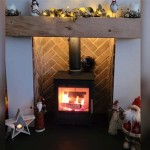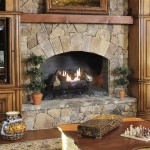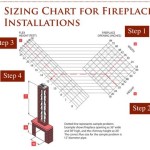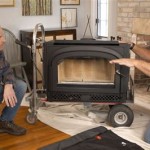Mock Fireplace Mantel: A Comprehensive Guide to Design and Installation
The mock fireplace mantel, a decorative structure designed to resemble the surround of a traditional fireplace, offers a focal point in a room without the need for a working fireplace. It can serve as a stylish architectural element, providing a platform for displaying artwork, photographs, and decorative objects. This article will explore various aspects of mock fireplace mantels, including design considerations, material choices, installation techniques, and styling options.
The primary function of a mock fireplace mantel is aesthetic enhancement. It adds visual interest and a sense of warmth and character to a space. Unlike functional fireplaces, which require significant structural modifications and safety considerations, a mock mantel can be installed with relative ease. It provides the appearance of a traditional fireplace without the complexities of venting, fireproofing, and fuel source requirements.
Design Considerations for Mock Fireplace Mantels
Designing a mock fireplace mantel involves several key considerations to ensure it complements the overall style and dimensions of the room. Understanding these aspects is crucial for achieving a cohesive and visually appealing result.
The selection of a style is paramount. Mock fireplace mantels are available in a wide range of styles, including traditional, modern, rustic, and minimalist. Traditional mantels often feature ornate carvings, detailed molding, and classic architectural elements. Modern mantels tend to be simpler in design, with clean lines and geometric shapes. Rustic mantels may incorporate reclaimed wood, exposed brick, or other natural materials. The chosen style should align with the existing décor and architectural features of the room.
Another vital aspect is the size and proportions of the mantel in relation to the room. A mantel that is too large can overwhelm a small space, while a mantel that is too small may appear insignificant in a large room. The height, width, and depth of the mantel should be carefully considered to achieve a balanced and harmonious look. Generally, the width of the mantel should be proportional to the width of the wall on which it is installed. The height of the mantel should be comfortable for viewing and displaying objects. The depth of the mantel should provide sufficient surface area for decorative items without protruding excessively into the room.
The placement of the mock fireplace mantel is also a crucial consideration. Ideally, the mantel should be centered on a wall and positioned to serve as a natural focal point. In some cases, it may be appropriate to place the mantel off-center to accommodate existing architectural features or furniture arrangements. The surrounding area should be free of obstructions to allow the mantel to be fully appreciated. This might involve rearranging furniture or relocating artwork to create a clear visual pathway to the mantel.
Integration with surrounding elements is essential for a cohesive design. The mantel should complement the color scheme, materials, and textures of the room. Consider the flooring, wall color, trim work, and furniture when selecting the materials and finish for the mantel. For example, a dark wood mantel may work well in a room with light-colored walls and hardwood floors. Conversely, a painted mantel may be a better choice for a room with darker walls or carpeted floors.
Finally, consider any intended use of the space within the mantel. Some mock mantels feature a recessed area that can be used to house an electric fireplace insert or other decorative elements. If an electric fireplace is planned, ensure that the mantel is appropriately sized and ventilated to accommodate the unit. Alternatively, the recessed area can be used to create a faux fireplace effect with candles, logs, or other decorative items.
Material Choices for Mock Fireplace Mantels
The selection of materials plays a significant role in the overall appearance and durability of a mock fireplace mantel. The choice depends on the desired aesthetic, budget, and level of maintenance required.
Wood is a popular choice for mock fireplace mantels due to its versatility, warmth, and natural beauty. Various types of wood can be used, each with its own unique characteristics. Solid wood, such as oak, maple, or cherry, offers durability and a classic look. These hardwoods can be stained or painted to match the décor of the room. Softwoods, such as pine or fir, are less expensive but may require more care to prevent dents and scratches. Engineered wood products, such as MDF (Medium Density Fiberboard) or plywood, provide a cost-effective alternative to solid wood and can be easily painted or veneered.
Stone and brick are other options for creating a more substantial and rustic look. Real stone and brick can be used to construct the mantel, but they are heavy and require specialized installation techniques. Faux stone and brick panels offer a lighter and more affordable alternative while still providing the appearance of natural materials. These panels are typically made of lightweight concrete or polyurethane and can be easily installed with adhesive or screws.
Metal can be used to create a modern and industrial look. Steel, iron, and aluminum are common choices for metal mantels. These materials can be finished with paint, powder coating, or other treatments to achieve the desired color and texture. Metal mantels are durable and easy to clean, but they may not be suitable for all décor styles.
Composite materials, such as polyurethane or resin, offer a lightweight and durable option for mock fireplace mantels. These materials can be molded into intricate shapes and designs and are resistant to moisture, rot, and insects. Composite mantels are available in a wide range of styles and finishes, making them a versatile choice for various applications.
When selecting materials, consider the overall style of the room and the desired level of maintenance. Wood mantels may require regular cleaning and polishing to maintain their appearance. Stone and brick mantels are relatively low-maintenance, but they may require occasional sealing to prevent staining. Metal and composite mantels are generally easy to clean and maintain.
Installation Techniques for Mock Fireplace Mantels
The installation of a mock fireplace mantel is a straightforward process that can be completed by a homeowner with basic carpentry skills. However, it is important to follow proper installation techniques to ensure a secure and aesthetically pleasing result.
Accurate measurement and layout are crucial for a successful installation. Before beginning, measure the wall where the mantel will be installed and mark the desired location of the mantel. Use a level to ensure that the mantel will be installed straight and plumb. Consider the height and width of the mantel and ensure that it is centered on the wall. A pencil will be needed to mark the wall at the desired dimension.
Next, prepare the wall surface. Ensure that the wall is clean, dry, and free of any loose paint or debris. If the wall is uneven, it may be necessary to shim the mantel to create a level surface. Locate the wall studs using a stud finder and mark their locations. These studs will provide a solid anchor for the mantel.
The method of attachment will depend on the weight and material of the mantel. Lightweight mantels can be attached using construction adhesive and screws. Apply a generous amount of construction adhesive to the back of the mantel and press it firmly against the wall. Then, drive screws through the mantel and into the wall studs to secure it in place. For heavier mantels, it may be necessary to use mounting brackets or cleats. Attach the brackets or cleats to the wall studs and then slide the mantel onto the brackets.
Concealing fasteners is essential for a polished look. Countersink the screws and fill the holes with wood filler or putty, depending on the material of the mantel. Sand the filler smooth and then paint or stain the mantel to match the existing décor.
Once the mantel is installed, inspect it carefully to ensure that it is securely attached and level. Make any necessary adjustments to ensure a professional-looking result. Clean any excess adhesive or sealant from the wall and mantel. Consider caulking any seams to ensure there are no gaps between the mantel and the wall.
Finally, style the mantel with decorative objects to create a focal point. Arrange artwork, photographs, candles, and other items on the mantel to create a visually appealing display. Consider the balance, color scheme, and overall composition of the arrangement to achieve a cohesive and harmonious look.

Faux Fireplace Mantel Surround

Diy Faux Fireplace Mantel Tutorial Grace In My Space

Diy Faux Fireplace Mantel With Tile And Brick

Schlafzimmer Wohnung Hausdekoration Dekoration Wohimmer Wohnideen Einrichten Hausdekor Faux Fireplace Diy

Diy Faux Fireplace Mantel Ideas On A Budget Using Easy To Use Tile Stencil Patterns From Cutting Edge Stencils Künstlicher Kamin Kaminbau

Easy Diy Faux Fireplace And Mantel Zucchini Sisters

One Of My Favorite Things To Decorate Is Our Fireplace Mantle I Don T Know What Mantles Were Originally Design Faux Diy

20 Gorgeous Diy Faux Fireplaces And Mantels Remodelaholic

Diy Faux Fireplace Dogs Design

Diy Faux Fireplace Mantel With Tile And Brick








